Australian
and international
exploratory
performance and
media arts
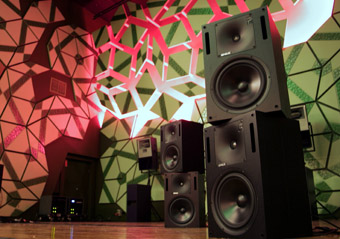
Bernard Parmegiani installation, Melbourne, LA4
photo by Mark Derbyshire
Bernard Parmegiani installation, Melbourne, LA4
“In 1999 a group of RMIT students presented a collection of experimental sound and music events. Ten years on, this collection of events, Liquid Architecture, has grown into one of Australia’s most significant festivals with a national touring program of concerts, installations and forums.” Gail Priest
In RealTime 91 Gail Priest interviews Liquid Architecture director Nat Bates to find out more about this year’s national tour and to look back at how the festival has evolved over the past ten years.
This selection from the RealTime archive also reflects on the festival’s history by singling out a few of its many highlights. Read about Bernard Parmegiani playing in Melbourne during LA4 in “liquid architecture: the parmegiani experience”, an event which Nat Bates remembers as his “number one highlight.” In “sound bodies”, a duet by Clayton Thomas and Jim Denley stands out as writer Tony Osborne’s “highlight of the week” when he samples Sydney’s LA7. Recalling last year’s LA9, “sounds solid, sounds fluid” highlights not one but “two outstanding performances”, those of festival director Nat Bates and Marcus Schmickler; the latter’s creation was “powerful, verging on spiritual, with no drugs required.”
sounds continuous
gail priest: nat bates, liquid architecture 10
liquid architecture: the parmegiani experience
simon sellars
sound bodies
tony osborne: liquid architecture 7, sydney
sounds solid, sounds fluid
gail priest: liquid architecture 9, sydney
Aucourant, AUREC, 0899-1
http://www.aucourantrecords.com
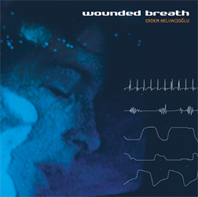 Turkish musician Erdem Helvacioglu is best known for his work with electric guitar and computer processing, drawing favourable comparisons with guitar/laptop artist Christian Fennesz (although Helvacioglu offers a significantly more polite if somewhat florid version of even Fennesz’s most accessible music). However with his latest release, Wounded Breath, Helvacioglu seems largely to have eschewed the guitar and instead produced an album of electroacoustic compositions.
Turkish musician Erdem Helvacioglu is best known for his work with electric guitar and computer processing, drawing favourable comparisons with guitar/laptop artist Christian Fennesz (although Helvacioglu offers a significantly more polite if somewhat florid version of even Fennesz’s most accessible music). However with his latest release, Wounded Breath, Helvacioglu seems largely to have eschewed the guitar and instead produced an album of electroacoustic compositions.
After several listens the overall impression is of digital reverberation. This is not to say that these compositions are geared towards any discrete exploration of the parameters or expanses of synthetic space creation, nor that they are pursuing reverberation as a means of sound production in and of itself. Instead there is the sense that echo, reverb and digitally induced spaciousness has been injudiciously applied to just about every sound in these compositions. While this may lend the album superficial production slickness, it has the effect of homogenising not only the sounds used to construct the works—which have effectively had any sharp corners or angles sheared away with the sonic equivalent of a sander and buffer—but the compositions themselves. Perhaps Helvacioglu’s work in film soundtracks might explain this overactive fascination with digital reverberation. However, even the sonic codes of mainstream action cinema don’t require quite this degree of synthesised echo.
It may seem churlish to chastise an artist for the overuse of a particular effect or form of signal processing. However, any argument that could be constructed in relation to other musical genres positing a division between electronic effects and an artist’s aesthetics is hardly applicable to electroacoustic or electronic music. An artist’s choice of the processes for modifying sounds is no more or less significant than their selection of sounds upon which those processes are deployed, if indeed these two features can be considered separately. A given sound, once affected or processed, is not only a new sound, it is the sound as heard in the work, and this is what listeners encounter. In some cases, processing is not an afterthought so much as the stimulus for the work. Therefore, in electroacoustic compositions such as these, processing must be considered not only as integral to the compositions, but a serious indicator of the aesthetics involved.
Unfortunately, listening beneath the echo isn’t a particularly rewarding experience. While the reverberation in these compositions might promise a series of potentially sensational spaces, they are ultimately rather drably adorned, or alternately filled with little of interest. Many of the sounds used here—despite how they may have been generated—will be familiar to even casual listeners of electronic music produced in the last 50 or so years: bleeps, bubbling yibbles, deep winding drones, shuffling white noise and so on. Structurally the works offer few surprises, following a simple (and well-worn) formula of peak and trough. This gives all the works a kind of unit structure that becomes maddeningly predictable long before the CD is through. Added to this is a reliance upon the cavalcade of affective clichés that echo is so often used to induce. Yes, the various reverberations all sound ‘great’ and fulfil all the related adjectives—‘rich’, ‘deep’, ‘cavernous’, ‘spacey’, ‘watery’, ‘cold’, ‘scary’ and so on—but regrettably it doesn’t leave the listener with anything much of interest to engage with. Swamped in reverb the sounds don’t really get much of a chance to speak for themselves, and, as a result, in a slightly strange way, neither does the artist.
Peter Blamey
Dual Plover/Kwanyin-Sub Jam 029, 2009
www.dualplover.com, www.subjam.org
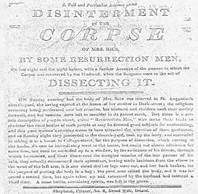 Lucas Abela has been exploring noise performance using a variety of self-constructed instruments for over a decade. Since 2003 Abela’s instrument of choice has been a sheet of glass, which he plays by humming, squealing and raspberry-blowing against it, the miked signal subsequently fed through a utility belt of effects pedals. The performance is spectacular and concludes when he smashes the glass over his head. Showmanship aside, the sounds Abela elicits in his improvised onslaughts are often extraordinary.
Lucas Abela has been exploring noise performance using a variety of self-constructed instruments for over a decade. Since 2003 Abela’s instrument of choice has been a sheet of glass, which he plays by humming, squealing and raspberry-blowing against it, the miked signal subsequently fed through a utility belt of effects pedals. The performance is spectacular and concludes when he smashes the glass over his head. Showmanship aside, the sounds Abela elicits in his improvised onslaughts are often extraordinary.
After touring extensively across Asia and Europe as a solo artist, Abela has settled on China as the home for his latest project—a band. Rice屎Corpse sees him join with experimental rock drummer Yang Yang and improvising saxophonist Li Zenghui trying his hand at piano. After four rehearsals and minimal language-based communication, the trio made a recording and went on a tour of China (courtesy of an AsiaLink residency). The resulting six track CD, Mrs Rice, is co-released by Abela’s Dual Plover label and Kwanyin, the sub-label of SubJam, run by artist and promoter Yan Jun.
Abela admits that this CD sounds nothing like anything he’s done before and he’s right. The use of piano and drums lend many of the tracks what could be described as a more accessible melodic and rhythmic drive than we have come to expect. This is established immediately in “Mountain”, where almost genteel piano notes are met by subtle under rumbles from Abela. These notes quickly develop into discordant jabs and a rocking drum section kicks in establishing a chunky middle section in which Abela takes a lead break squealing the track to a new intensity. It’s a catchy and romping jazz-fusion piece that you could actually dance to if you were so inclined.
This comfortable zone is immediately undermined by “Stamp on my balls.” Discarding tight cohesion, it reveals the artists on exploratory journeys with occasional collisions. Abela purrs and sucks, the piano skitters, there are sudden drum punctums along with distant howls and caterwauls in Mandarin. This is call and response—the artists getting to know each other musically, offering and borrowing, creating a spacious piece that shifts through a variety of dynamics.
In “Desktop Frog” there's a collective launch: a brittle scattering of drums, washes of piano notes and growing undulations on glass creating the effect of bad weather approaching. Abela takes over, producing tones akin to organ notes but with a metallic edge, wailing and moaning, until a four beat drum count down introduces splatter hysteria.
Several of the tracks are tangibly gothic, a mood amplified by the morbid newspaper story reproduced on the sleeve about Mrs Rice, a woman from Bristol in a past non-specified, whose body was disinterred for its organs not once but twice. The title of track 4, “Resurrection Men”, is taken from the same article and its pounding piano progressions, primal drum rolls and the mounting intensity of Abela’s freeform swirls certainly suggest the Boogie Man is coming to take us away…This track is wild and expansive and yet completely integrated. My personal favourite.
“Peking Duck” could be called a song. Abela sings along, matching piano and drums note for note, sounding like Rolf Harris’ wobble board crossed with a duck. It’s a short pounding track showing yet another kind of conversation between the artists.
It’s hard not to read the gruesome body snatchers narrative into the final track “Mrs Rice.” Low piano notes and wide handspan chords offer a silent film ambience, while Abela creates low burblings and deathly moans. Yang Yang's drums come to the fore with sporadic bass drum thumps like hands banging on a coffin, accompanied by cymbal skitterings and the track ends, again, in an all out squall.
As a whole Mrs Rice is a fascinating experience. It certainly has its moments of noise assault but the dynamics between and within the tracks are testament to the improvisatory skills of the artists, and a sense that they are seeking new territories. The persistence of Zenghui’s piano stabbing and jabbing wears thin by the end, and I feel that Yang Yang’s drums often get lost in the mix with the recording muddied every now and then by total overdrive. What is most interesting about Mrs Rice is the intense cohesiveness of the ensemble and the range of explorations encapsulated on the six tracks. Doubtful he'll be able to bring the Chinese artists to tour, Lucas Abela is in the process of exploring a similar band format in Australia.
Gail Priest
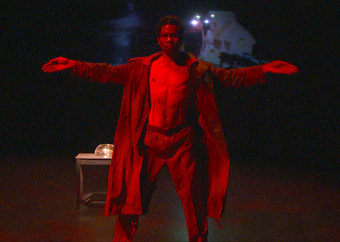
Earl Rosas, Whispering Limbs, Bonemap
IN WHISPERING LIMBS THE VERY FORCES OF NATURE HAVE MORPHED AND DISTORTED. WE ARE GRIPPED BY A FEELING OF FOREBODING. AN UNDERCURRENT OF BURGEONING CHAOS BUBBLES BENEATH THE SURFACE OF THIS STRANGE PARALLEL LAND.
Those who dwell here are twisted, hybrid versions of humanity, moving with a strange blend of supreme elegance and exaggerated rigidity, teetering and towering on stiletto heels, then shuffling ominously like the dancing undead.
Bonemap’s new work takes us into a dark, cosmic realm fraught with unseen danger and illicit desire. It is a creative explosion of diverse dance and movement, haunting soundscape, evocative new media art and vivid costume design. Whispering Limbs furthers Bonemap’s deeply introspective dialogue with nature, exploring ecology through physical and visual expression. Here Rebecca Youdell and Russell Milledge collaborate with dancer Earl Rosas and Brisbane-based performance ensemble Polytoxic.
At the show’s beginning Rosas appears like an ancient shaman. He enters slowly and carefully, a goldfish bowl filled with water balanced precariously on his head. Concentration is etched on his face, the atmosphere tense and electric as his dark, sinewy limbs twist, bend and mould in a precise articulation of quiet, renewable strength and infinite balance. Like a mystic yogi he meditates on deep, unspeakable thoughts, encapsulated in the spherical vessel. Or perhaps he is a titan, suspended in space, carrying a blue planet.
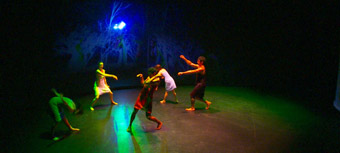
Bonemap, Whispering Limbs
But there are new images to dream on. A large, creamy cloud of stiff cloth rises in a box high on the wall. As it floats and expands an arm emerges, like a seeking periscope. It darts and curves gracefully as if with a life of its own. A woman’s face and torso follow the arm and the cloud becomes an elegant ballgown.The woman dances, like a beautiful figurine in a music box, the skirt billowing below her. She pushes it down again and again, but soon it consumes her and plunges both of them back into darkness.
We enter other worlds of dancing dolls and dresses. Rebecca Youdell struts about in tutu and clunking boots, chews gum and glares at the audience, nonchalant and distinctly unimpressed. Her brattish rudeness unleashes itself in a dance of pure, unadulturated glee; her delicate, agile spins and twirls amaze and utterly captivate. But she grows bored. With wicked playfulness the doll-like figure launches into a bizarre, somewhat disturbing corroboree. Before her performance ends she unfastens a tired corsage of weeds and hurls it into the audience, like a demonic bride tossing her floral bouquet.
These are just some of the vivid imaginings which form the surreal collage that is Whispering Limbs. Water is a recurring, connective theme. At one point three performers appear in raincoats and gumboots. They trudge across the stage, water leaking from within their coats. It rains from them. They tip their boots in unison, pouring the water into a pond. In the finale Rosas returns with his water vessel and goldfish. This time he places it high on a metallic structure as menacing girls in old-fashioned, hooped skirts lurk threateningly underneath. Could it be, in this nightmarish ending, that this fish-bowl world is symbolic of our own?
Whispering Limbs is an intoxicating, immersive, hyper-sensory experience—a dark dreamscape. We feel the beauty and coarseness of nature and ponder the ambiguity and unpredictability of the human psyche as the work’s blend of rich imagery and delicate symbolism burn into the memory.
On Edge, Bonemap, Whispering Limbs, design, media Russell Milledge, composer Steven Campbell, performers Rebecca Youdell, Earl Rosas, Polytoxic [Lisa Fa’alafi, Efeso Fa’anana, Leah Shelton]; JUTE Theatre, Cairns, July 9-11.
RealTime issue #93 Oct-Nov 2009 pg.
© Kate Cooper; for permission to reproduce apply to realtime@realtimearts.net
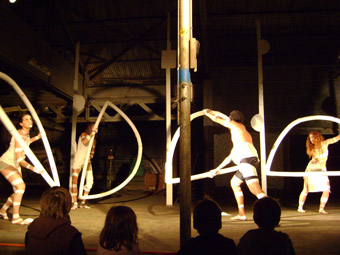
Cast, Blueprint, Zane Saunders
photo Jenny Fraser
Cast, Blueprint, Zane Saunders
FOUR EPHEMERAL FIGURES EMERGE FROM BEHIND TALL, METALLIC TREE-LIKE SHAPES AT THE BACK OF CRATE 59’S DECAYING INDUSTRIAL SITE. MARKED IN WHITE CLAY AND WEARING STRIPS OF CLOTH REMINISCENT OF BANDAGES, THE PERFORMERS APPEAR TO BE FROM ANOTHER TIME AND PLACE.
They clasp bony, life-sized, half-moon structures—the shape echoed in their facial markings. Together they guide us through a re-imagining of traditional fire and land clearing practices in Cape York. Fluid in their symbology, the performers morph from spirit to animal to human and back again.
Blueprint, a new work conceptualised by indigenous artist Zane Saunders for the On Edge festival in Cairns incorporates dreaming, circus references and the everyday to create a trance-like elegy for the dying land. We see natural formations and ancient tribes displaced by the elements, ingeniously represented by tiny styrofoam beads tossed by wind. In a burial ceremony the audience are invited to offer flowers to the deceased land at a half-moon grave.
In the aftermath of this event Saunders presents us with an indelible image. A battered fan turns the pages of what appears to be a bible and scatters printed images across the floor. Here the lines between performance and installation blur. We are cued for grief and let into the moment with a Bob Dylan track from a ghetto blaster. We are reminded that, yes indeed, “The times, they are a-changin.” A hazard light, stage left, flashes a yellow sunset as the lights dim and the first part of Blueprint ends, with an apparent snuffing out of human and animal life.
This vignette of grief has its companion piece in part two of Blueprint, where the performers celebrate regeneration of the land and the renewal of life. There is fresh energy and a greater sense of pace, and after a time, the land is re-born. Domino-like structures, possibly monuments to civilisation or colonial invasion, are knocked down. Lines of string demarcate—and perhaps reclaim—this land as spiritual territory. Like a tightrope walker, Saunders takes centre stage, balancing a long pole horizontally in his hands, while walking intently towards us. The intensity of the action is juxtaposed with Saunders’ relaxed grip as he appears to embody the spirit of both creation myth and circus performance. A ritualistic fire ceremony ensues, the performers lighting incense coils. Curls of smoke permeate the space and soften the raw industrial feel of Crate 59.
Blueprint is a new work exploring environmental management issues in an evocative, and sometimes abstract, way. It reminds us that, while it must go though fire to yield new beginnings, our land should be afforded all the ceremonies we would a loved one.
Zane Saunders, Blueprint, with Jess Jones, Joelle Baines and Hanzard, sound Nicholas Mills; Crate 59 Gallery, July 9 & 11..
RealTime issue #93 Oct-Nov 2009 pg.
© Victoria Carless; for permission to reproduce apply to realtime@realtimearts.net
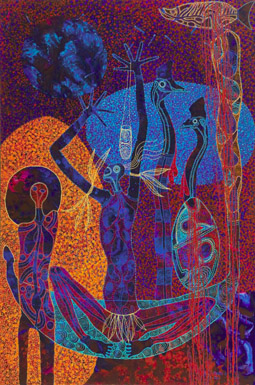
Cassowary Dream, Arone Meeks
image courtesy of the artist and Cairns Regional Art Gallery
Cassowary Dream, Arone Meeks
A sharp rustle of leaves disturbs the gentle drone of distant traffic. A lithe, nimble figure emerges from the shrub. She darts ahead, disappearing into the distance; a woodland nymph in white trainers.
Steady footsteps tracing a barren path are the initial, glaring feature in Barbara Dover’s video, Looking for Blue Arrow. The slightly shaky handheld camera brings forth a toxic rush of adrenaline and a subtle, sickly claustrophobia as it navigates a swirling track of dry, crunching gravel and bare, wooden stairs carved into the landscape. Surrounded on both sides by sparse vegetation, the unseen subject slows and breathing intensifies, capturing a vivid sense of that desperation and fear felt by hunted prey.
The walker, with camera, is on the Blue Arrow Walking Track in Mt Whitfield Conservation Park, north of Cairns—Cassowary Country. Etched in a sign is the word BLUE and an arrow symbol. The letters are like markings on a gravestone, but the name itself has become irrelevant, obsolete. All that remains is a sad irony. Blue Arrow, the last cassowary of a population which once inhabited the area was attacked and killed by two pet dogs in 1996.
Dover’s work is part of a Cairns Regional Art Gallery exhibition, This Is Cassowary Country, a vibrant hive of visual splendour, drawing from a diverse range of artists and media to explore the conflicting relationships between humans and the creatures with whom we share our environment. There are finely crafted ceramic and glass pieces from Mollie Bosworth and Terry Eager, as well as a series of woven works from Susan Doherty. Gerhard Hillmann also exhibits a colourful collection he describes as an “organic photo montage.”
Local Aboriginal artist Arone Meeks draws from traditional history and artistic techniques in creating his own striking, spiritual manifestation of the cassowary, titled Cassowary Dreams.
The regal bird gazes out from an acrylic portal contained within a mythic realm. His crest of bone and skin sits upon him like a crown. So otherworldly, yet humanized, this majestic beast could be an ancient hieroglyph of an Egyptian god. But he is a god that bleeds. A dark, crimson stain oozes from his chest like a scar on the canvas or a crack in a cave wall. Meeks injects a surreal, almost sci-fi ambience into his work. The electric blues and lava-like brush strokes place his mystic, archetypal characters in a distorted, volcanic landscape which transcends time and space.
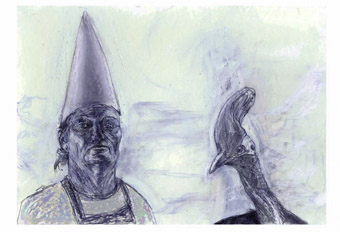
If the Cap Fits (from column installation Follies), Margaret Genever
image courtesy of the artist and Cairns Regional Art Gallery
If the Cap Fits (from column installation Follies), Margaret Genever
Margaret Genever contributes a significant portion of the exhibition. One of her works is a three-piece collection of mixed media installations in which circular windows open onto complex, re-generating worlds.
View from the Heavens is a mish-mash mosaic of shoes, painted black, jutting out from a spherical base, and looking like ashen, post-apocalyptic rubble. At second glance, flecks of blue and red peer shyly through the slick, oily veneer, like rare cassowaries in a desolate urban wasteland.
There are gumboots, grandma’s sensible pumps, the iconic Aussie thong, a strappy pair of heels, a child’s slipper, the cartoon face of a dog still prominent under the thick paint. Connotations of carbon footprints confront the viewer at eye-level. These are the stiff, mundane shields which we don each day to protect ourselves from the earth, eliminating the sensation of touch, allowing us to tread without pain or awareness.
Directly behind this work is an installation titled View from the Centre of the Earth. Layered on shoe soles is a fascinating and fragile ecosystem. The skeletons of leaves are exposed and imprinted on the earth. Intricate debris and delicate remnants of butterflies dwell below the surface. A dragonfly is perched precariously on one sole, perfectly formed and preserved despite the weight of the world balanced tenuously on tiny wings.
The third work, View from the Future, is on the floor. Leaves like snowflakes lie undisturbed and frond prints in charcoal dust dance on a forest floor. There are no shoeprints stamped clumsily without care and thought. No trace of humanity. Just as there are no arrowed footprints planted softly in the earth by a flightless phoenix of red, blue and black.
Genever articulates a prophetic sentiment which resonates throughout the exhibition. Our existence and the survival of the cassowary are directly entwined.
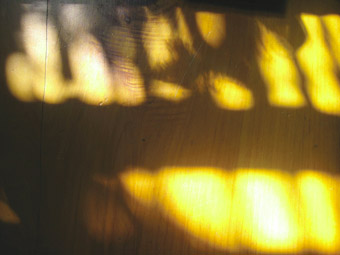
Peripheral (video), Beth Shorter
image courtesy of the artist and Cairns Regional Art Gallery
Peripheral (video), Beth Shorter
Imagine drifting contentedly through an afternoon in your cosy home. Your eyes are half closed. You are on the periphery of consciousness. Particles of light leak through your eyelids. Colours swirl in the room like dust motes until you’re breathless and dizzy. Shapes arrange themselves in some sort of strange celestial dance.
Some artists strive to be at the cutting edge. Beth Shorter’s mixed media works in Peripheral, however, explore this notion of being at the edge of things in an ephemeral, rather than an in-your–face way. Her subject is the nature of light in domestic spheres—the ordinary spaces or “non-places” that, upon closer inspection, reveal little worlds full of pattern and colour.
In Ambiguous Highlight, a slide image on paper, amoeba-like spheres rendered in baby pink and blue float in a field of ink and midnight. An ochre crescent grounds the work, although this sensible colour is mostly relegated to the sideline. Ambiguous Highlight’s companion piece, Accentuated Light, sees the same pastel orbs morph and multiply—are they engaged in a courtship dance or fighting to each outshine the darkness? These pieces owe something to clever out of focus camera work and have a shifting, transitional quality.
Their digital sister work, Unobserved Objects, delivers a more heady rush of colour with traffic light red and green, that iridescent blue particular to insects and Moroccan mosques, and variations of lilac, turquoise and aquamarine, all afloat in the night sky. This work makes me think of driving at night through the rain, where city lights take on the quality of a hazy, enticing carnival. But then, another viewer might see something entirely different.
This exhibition, comprising both digital and slide prints on bamboo paper, oils on canvas, short film and installation, invites interpretation while celebrating ambiguity. The oils, interesting technically, also contribute to the overall ephemeral effect, although occasionally they tend to concretise the subject that elsewhere dances in everyday spaces.
In the short film, Shorter initially draws us in with indistinct green shapes. You may just make out some organic matter—is that a lacy palm frond stirring in the breeze? Once recognition has taken place the work assumes the feel of a balmy night in the tropics. Then, a segue, and we gradually see more literal objects as the camera moves in and out of focus. We contemplate various surfaces in the domestic space, such as a brick wall, a timber fence and ridged heavy fabric, although these items are never precisely placed. It is more about textures and their collective effect on the viewer.
The celestial notion of the images on paper is continued in the installation titled Shadow Play. Comprising movable ceramic disks suspended from the ceiling like a children’s mobile, this is an interactive piece that invites the viewer to enter the artist’s realm. By moving the disks you are able to manipulate the interplay of objects, and observe the resulting shadows on the blank canvas of the gallery wall. Once again we see the interconnectedness of objects and light create beguiling patterns in space. This time it is the viewer and not the artist who manipulates the medium to see the light.
In her artist’s statement Beth Shorter writes briefly about the specific spaces she has inhabited, three separate houses in Far North Queensland, and how her work is specific to the light, foliage and interior details of these environments. While it is true that delicate palm fronds at the edge of things evoke the tropics, and that light may be particular to place, in the manipulation of these elements Shorter has also created other worlds. In these familiar “un-spaces” are other meanings all our own.
These gentle and intriguing works have the effect of winding one’s mind down, a lovely thing in our increasingly frenetic world. Meditative, experiential and intimate, take the time to allow these pieces of everyday magic to come to you.
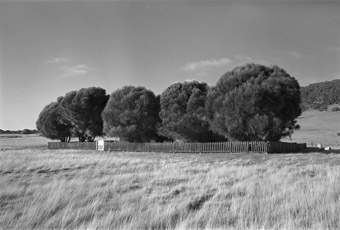
The Healing Garden, Wybalenna, Flinders Island, Tasmania from Portrait of a Distant Land, 2005. silver gelatin print
copyright Ricky Maynard, courtesy Stills Gallery
The Healing Garden, Wybalenna, Flinders Island, Tasmania from Portrait of a Distant Land, 2005. silver gelatin print
“It’s pretty important you know, the land, it doesn’t matter how small, it’s something, just a little sacred sight, that’s Wybalenna. There was a massacre there, sad things there, but we try not to go over that. Where the bad was we can always make good.”
Indigenous Tasmanian speaker
The Healing Garden, Wybalenna, Flinders Island Tasmania is one of many images from Portrait of a Distant Land, a retrospective of Ricky Maynard’s photography staged by Sydney’s MCA and exhibited at Cairns Regional Gallery. Initially the landscape is seemingly serene and rustic—grassland with several velvety trees enveloped by a forlorn picket fence. Apparently innocuous, the composition of the landscape draws you in, with its luminous gate and rickety fence that bind the spongy trees. What incredible trees. Am I looking at a sacred site, a site of worship? Only upon reading the accompanying text do I learn of the ghastly horror commemorated here, accentuating the burden Indigenous Australians have to bear and their determination to survive.
Ricky Maynard is an award-winning Aboriginal photographer who lives and works on Flinders Island and is one of the Ben Lomond/Cape Portland people. His finely crafted black and white prints are neatly framed in rosewood, but the images are sometimes raw and often haunting. Portrait of a Distant Land combines discrete lines of inquiry from five exhibitions over two decades of documentary photography. And to this overview Maynard adds the byline, “Do not forget these faces—they hold something you would not believe.” Hence an individual’s face, a description of circumstance, the surface of an environment, all imbue the collection with multiplicity and meaning.
In the early 1980s Maynard began his journey to capture through the camera his culture—landmarks, people, places and experiences which would otherwise have been lost or gone unrecognised. His dedication to documenting histories of Indigenous peoples is revealed in his considered choice of subject matter—certain eras, places, jobs, kinds of country and everyday life.
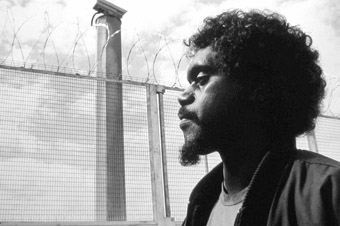
Untitled from No More Than What You See series, 1994
copyright Ricky Maynard, image courtesy of the artist and Stills Gallery, Sydney
Untitled from No More Than What You See series, 1994
The insight into daily life takes the viewer into a range of situations, from the heart of Tasmania to the tip of North Queensland, from the bush to the ‘burbs, from expanse to confinement. In No More Than What You See (1993), an untitled image of a man looking in the mirror shows the plight of incarcerated indigenous people in the South Australian prison system. The black border of the photo seriously constrains the image, the technique continuing throughout the series. These works are aptly hung in a cell-like room of the gallery, amplifying the sense of restriction. We see the out of focus back of a man in his 20-30s, looking into a rivet-framed mirror, in sharp contrast with his focused reflection. The white walls and mirror that frame his head and chest, the tube of toothpaste and assorted toiletries evoke a stark existence and a sense of despair. Again Maynard’s simple composition provides visual interplay as the eye darts back and forth between the two perspectives, animating the image and giving it life, if a bleak one.
This state is juxtaposed with indigenous triumphs. The portraiture from Returning To Places That Name Us 2000 is a series of large scale headshots, defiant in the face of horrible injustices. The photographs are inspired by the landmark High Court of Australia ruling that recognised the existence of traditional lands of the Wik people in Cape York, North Queensland. The images fill the gallery like Easter Island guardians. One such portrait, the face of Joe, Wik Elder, shows a wise and knowledgeable Aboriginal man fixing a penetrating gaze upon his lot. The white prickly beard, wiry hair, creases on the forehead and pursed lips suggest a steely presence. Joe appears to be missing an eye in the dark deepness of his face. I have to move several times past the glare from the gallery light, to see what is not there. Perhaps more considered composition, or Maynard magic.
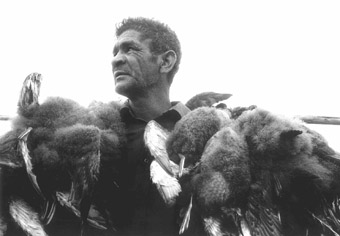
Athol Burgess from The Moonbird People series 1985-88, printed by the artist 2007
copyright Ricky Maynard. Image courtesy of Australian Institute of Aboriginal and Torres Strait Islander Studies, Canberra
Athol Burgess from The Moonbird People series 1985-88, printed by the artist 2007
Returning To Places That Name Us 2000, The Moon Bird People 1985-88, Urban Diary 1997, In The Footsteps Of Others 2003, and No More Than What You See 1993 and ten new images are the works that comprise Portrait of a Distant Land. Maynard’s choice for his portraiture and landscapes are black and white gelatin silver prints rather than colour. This makes for a more neutral setting for this highly evocative work whose sense is historic rather than emotive.
Portrait of a Distant Land provides a poignant and reflective expedition for the viewer. It offers cultural insights and gestures that are revealing of traditional and contemporary life. While reminding me of the challenges facing these people, I was left with a sense of hope for the reclaiming of Indigenous culture—exhibiting Ricky Maynard’s photography, especially his Wik work, here in Northern Queensland suggests the possibility that a viewer might find a relative staring back at them.

Earl Rosas, Whispering Limbs, Bonemap
A dancer, Earl Rosas, enters a darkened space, bare-chested. He balances a bowl with goldfish on his head. Subtle images of ripples are projected on a large screen on the back wall, underscored by watery musical rhythms. The dancer fluidly eases his way to the floor, as though the life he bears is sacred. The right angled shapes he makes with his arms are intriguing, hinting at ritual, and so precise and contained that I soon lose my fear for the fish’s safety.

Bonemap, Whispering Limbs
Rosas exits and the mood shifts: enter a troupe of bright young things, two men (Rosas and Efeso Fa'anana) and three women (Rebecca Youdell, Lisa Fa'alafi, Leah Shelton) dressed in their best sharp suits and elegant dresses. Powerful synchronised articulations belie their demure appearance. They also manifest on the wide screen behind, running fast-forward over a neat lawn, evoking partygoers at an afternoon garden soiree. Gradually, onstage the dancers break form, their movements becoming disjointed and irregular. They appear disturbed, even slightly manic, as they work their way through a kind of collective bodily neurosis, moving towards a tall cylindrical scrim; a white bone in the dark.
Slithering under the scrim they undress to reveal silk slips—the men too, one in a lacy black number and the other in red. Now the performers are less constrained, transformed even. They slither out and once again we see their doubles in projection. This time they move through a midnight bushland setting, their urgent pace contrasting with the ghostly sentinel-like trees.
More striking moments ensue; memorable are the eerie image of a girl floating in a suitcase holding a single light globe, and an extraordinary representation of a live 'meringue' doll. Here, the performer brings an innocuous piece of white material to life. She emerges from it slowly as if from a cake or a cocoon. The material then morphs into a skirt which although voluminous restricts her movement. This beautiful metamorphosis may ultimately be a limiting one.
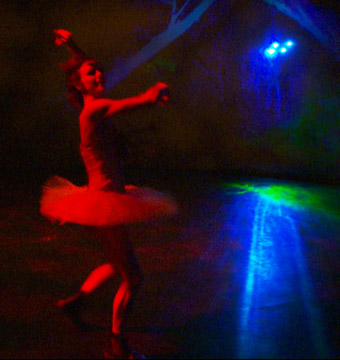
Rebecca Youdell, Whispering Limbs, Bonemap
The funny bone gets a tickling too; Rebecca Youdell’s quirky bush ballerina throws us her bouquet of weeds at the end of a gum chewing interlude, and Efeso Fa’anana’s figure in overalls fusses over a perfect circle of lawn, before handing out a piece to an audience member as if it were a slice of real estate.
The theme of water is revisited in the form of three raincoat clad creatures in gumboots trudging over to a small pool. Here they proceed to drip and leak slowly from their costumes as if beings made entirely of liquid. Perhaps this is an ironic comment on water consumption in these times of climate concern.
Shadow play is another device explored in Whispering Limbs. At one point the three female dancers teeter behind the scrim in exaggerated heels, hats and structured hoop skirts. They posture suggestively, their shadows evoking a larger than life burlesque show. Here we are caught between the real bodies of performers and their darker spirits, privy to the interplay of the tangible and the ephemeral. This sequence climaxes with the arrival of a metallic frame structure, where the fish makes its final appearance. The bowl becomes a coveted item for the dancers, instigating a mad scramble for possession. Thankfully, the enigmatic man of the first scene ensures its survival. We are left with the image of this serene being holding the goldfish in the bowl, just as the world holds him in its lulling turn. Order has been restored.
Whispering Limbs evokes issues and images of spirituality, ecological sustainability, transformation and doubling, generating a metaphysical whirlpool of ideas and images. The media components integrate with the physical performance perfectly to produce a work that, in the end, defies categorisation. Beautiful and strange, Whispering Limbs is part dark ritual, part mad hatter's tea party.
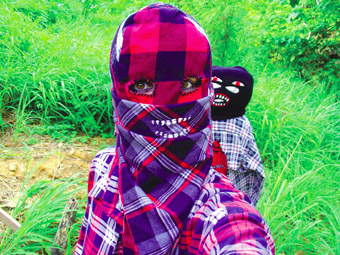
Combat Drag (video still), 2008, Jemima Wyman
images courtesy the artist and Milani Gallery Brisbane 2009.
Combat Drag (video still), 2008, Jemima Wyman
It’s night (cam). You’re in the scrub, playing at bushrangers. A voice from the rough end of hell tells you, “It’s coming to get us.” Is this your big brother playing tricks, or something far more sinister?
In Jemima Wyman’s video work Combat Drag a small army of flannelette-clad forms stake out their territory. Like YouTube zealots they posture and pose with menace in out of the way places, waving twigs as if they were guns. These figures have an essence of the Monkey Magic ninja, but also of dispossessed Australian youths. In addition to the iconic flannie, the performers in Combat Drag wear exquisitely crafted woollen masks with sewn expressions—like those belonging to the slightly odd-shaped toys you can buy in gallery shops. Only the performers’ mouths and eyes are visible, enhancing a fearful sense of the unseen and unknown.
This work disconcerts by skewing the familiar. Cultural symbols, ideas about identity and images of extremism trip each over each other. The strange masks, ‘terrorists’ in flanelette, ambiguous setting and a disturbing voiceover alerting us to the approach of “something big and scary” collectively evoke a corporeal response. The fear we are meant to experience, nonetheless, feels contrived and ironic—we are told in no uncertain terms that we should be afraid.
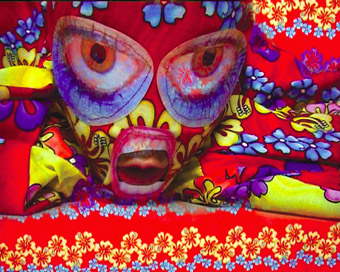
Whak’emall (video still), 2006, Jemima Wyman
images courtesy the artist and Milani Gallery Brisbane 2009
Whak’emall (video still), 2006, Jemima Wyman
More menacing for me is the work titled Whak’emall, which features a figure somewhere between a tantrum-throwing toddler and another backyard terrorist. Masking is also featured in this work, with the toy-like puppet toddler/terrorist garbed in a vertigo-inducing hibiscus-printed coverall. This garment has a homemade quality about it: part pyjamas and part straitjacket. Here too, the headpiece is customized, this time with appliquéd facial features and a hole cut out for the performer’s mouth. Red squiggles suggest the bloodshot eyes of a character both temperamental and nightmarish.
At one point the performer spins the mask to reveal a similarly disturbing face on a yellow hibiscus background. The personality of the subject does not change, despite the disorienting shift in camouflage. Different factions adopt different guises but the militant ideology remains the same.
The construction of this video work has a calculated naivety, its visual and audio quality evoking a YouTube posting or sinister home video. Wyman aims to disarm us, using familiar techniques to frame her disturbing figures.
Whak’emall and Combat Drag evoke a subjective state where extremists—be they toy, toddler, suburban youth or terrorist—find a sense of belonging and achieve oneness by donning masks. But along the way, Jemima Wyman leaves plenty of gaps into which we may insert other meanings of our own.
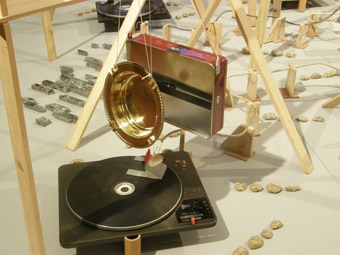
Ernie Althoff, The Middle Eight, Geelong Gallery
courtesy the artist
Ernie Althoff, The Middle Eight, Geelong Gallery
You can hear Ernie Althoff’s work as soon as you enter the Geelong Gallery—a quiet, metallic ringing—and as you walk around the gallery, gentle sounds permeate the space and affect your appreciation of the art on display.
Althoff’s work, The Middle Eight, sits on a long, low plinth on the floor of an otherwise empty room in the centre of the gallery, adjacent to another, larger room that contains the main body of work in the exhibition, The Freedom of Angels, Sculpture in a Century of Upheaval, of which it forms a pivotal element. In a program note, Althoff explains that the work’s title refers both to the geometry of the room, which is in the middle of the gallery, and to “the musical term denoting the ‘bridge’ part of a pop song that differs from the verse-and-chorus units. Hence, The Middle Eight signifies both the physical structure of the installation and the music it plays.”
This survey exhibition includes works ranging in style from neo-classical, such as Cesare Lapini’s delightful late 19th century marble The Kiss of Love, through modernist to postmodern, including the powerful abstract steel fabrications of Clement Meadmore, Inge King and Ron Robertson-Swann, the ironic assemblage of Aleks Danko and Rosalie Gascoigne’s transcendentally beautiful panels made from found crates. Mounted on industrial scaffolding rather than conventional museum plinths, the works in this exhibition, by some of the most important figures in Australian art, traverse the range of visual language and cultural perspectives of the 20th century, an era from which we have now perhaps gained sufficient distance that we can fully appreciate the enormous social, technological and artistic changes that it encompassed.
The Middle Eight comprises nine old phono turntables sitting beneath timber frames that support a variety of metal and timber objects, including eight brass gongs, various baking tins and food cans, some augmented with springs, and small sheets of plywood. Mounted on the turntables are small metal brackets and, as the turntables revolve, the brackets strike dangling strings fitted with hammers that strike the gongs, tins and other objects to produce a range of delicate ringing and clattering sounds. The result is like an eight note gamelan augmented by other sounds, and with only small differences between its tones. The swaying hammers aren’t always activated at every revolution of the turntable, and even when they are, they might not strike the target object — there is a high level of chance built into the work. The components are generally cheap, found objects, but assembled with much care. Even the electrical cable connecting the turntables is laid out on small plywood mountings, and rows of small stones are arranged in between the turntables to add another visual dimension to the work. The turntables turn at the uniformly slow speed of 16 rpm, and given the low probability of the hammers striking their targets, there are often long pauses between particular tones, and the melodic sequence that results is endlessly variable. The overall effect is of ambient sound a little like wind-chimes but more complex. In the uniquely resonant space of the Geelong Gallery, this music is intriguing and seductive.
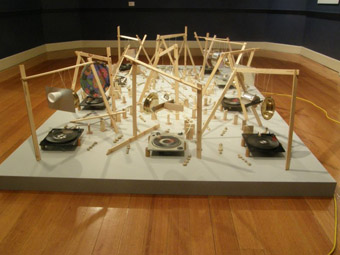
Ernie Althoff, The Middle Eight, Geelong Gallery
courtesy the artist
Ernie Althoff, The Middle Eight, Geelong Gallery
Althoff has been making kinetic works of this kind since the late 1970s. Typically they involve the use of very simple objects set up to generate a variety of sounds, sometimes meditative and sometimes chaotically loud and intrusive. In some previous works, Althoff has included audience participation in the design, but here the audience simply looks and listens. Conceptually, there is irony in the artist’s use of the turntable, which was invented to replay recorded sound accurately, but which is now used to generate new sound aleatorically.
The sculpture exhibition draws on a quote from Michelangelo, “I saw (an) Angel in the marble and carved until I set him free.” Althoff’s work sets sound free from its metal and timber constructions. Through the twin catalysing forces of electrical power and the composer’s design, sound is now encouraged to flow from musical and unmusical objects. The listener can experience and understand familiar ambient sounds anew, and better understand what it is to engage in the act of making sound or music. By using electro-mechanical devices (the turntables) to activate the tins and gongs, Althoff shows how the musician catalyses an object in a way that establishes its meaning and renders it an instrument. These electro-mechanical devices parody human musicians executing a score. The score, or orchestration, is not as precise as those of some other mechanical music-making devices such as player-pianos, but is more calculated and precise in nature than, say, a chime activated only by the wind.
Showing The Middle Eight in a sculpture exhibition contextualises Althoff’s work as sculpture rather than as sound art or performance. In the concert hall, the work would be judged against other forms of musical performance, and we now see how this interpretation can limit appreciation. When seen as sculpture, Althoff’s work enlarges our understanding of musical objects, visual art objects and everyday objects, questioning the distinction between commonplace materials and art. Importantly, it adds to the exhibition the elements of the electro-mechanical device, kinetic sculpture and Art Povera, completing the Geelong Gallery’s finely detailed picture of 20th century sculpture.
See Dean Linguey’s interview with Ernie Althoff : RT #70, p46
Ernie Althoff, The Middle Eight, in the exhibition The Freedom of Angels, Sculpture in a Century of Upheaval, Geelong Gallery, May 8-July 5
RealTime issue #91 June-July 2009 pg. web
© Chris Reid; for permission to reproduce apply to realtime@realtimearts.net
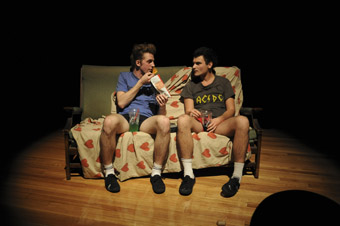
Tully Arnot and Chris Petkovic performing Beavis and Butthead, NightTime: Petty Theft, Performance Space
photo by Heidrun Löhr
Tully Arnot and Chris Petkovic performing Beavis and Butthead, NightTime: Petty Theft, Performance Space
A character straight from a B-grade sci-fi film speaks amicably to a small group of people of his expeditions aboard a grand star ship. He tells us that there is no currency in the future, but muses he is glad to be with us tonight in our present. Video records of his adventures in space play on stacks of old TV sets behind him. The footage is ripped from Star Trek, the Next Generation. This is Matt Rocheford’s performance, part of the first half of NightTime: Petty Theft.
In the most recent of Performance Space’s periodical short works nights artists were encouraged by the curatorial team to borrow, steal, appropriate and remix—all in the name of art.
The CarriageWorks Bay 20 theatre was set up for standing and mingling amongst installation works in the first half. Tully Arnot and Chris Petkovic sit on a couch being Beavis and Butthead. Video works by Jorey Corson and Blaine Cooper are looped on a commandingly large screen. In an intimate performance Phil Spencer asks you to sit on a milk crate opposite him and confess ‘have you ever stolen something?’ For your confession you are rewarded with a cashew nut.
I noticed a distinct ambivalence in the works staged towards the moral ground on which ‘theft’ stands. Underlying this was a questioning of the terms on which an artist can appropriate others’ words, images and ideas, and rehash them for their own work. When is the remix quotation and when is it plagiarism? And what is the outcome of the constant recycling of cultural icons? Some works suggested reference as flattery, some were critical or derisive of their original, and a few (and this is the danger of remix) were simply derivative.
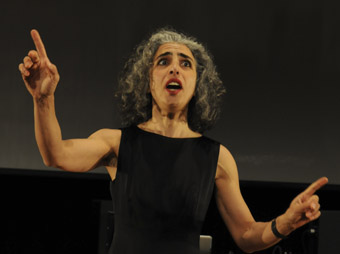
Katie Molino performing Already Gathered, NightTime: Petty Theft, Performance Space
photo by Heidrun Löhr
Katie Molino performing Already Gathered, NightTime: Petty Theft, Performance Space
The second half, a sit-down show, was a clash of theatre-type performances and multimedia and film works. Brown Council came out in T-shirts that read FRESH, NOW, HOT, HYPE. Recycling historic images of feminism and pop music, they feebly tried to set fire to their nylon bras (now removed) with cigarette lighters to Beyoncé’s hit song “All The Single Ladies.” I doubt that Beyoncé got royalties for this performance.
In a self-reflexive monologue Katia Molino affirmed the claim that everything in the theatre has already been done. A Soda-Jerk film constructed an hilarious fictional history of hip-hop culture entirely through sampling existing footage and sound—appropriate given the abundant use of samples and remix in hip-hop music.
The finale for the evening was audio-visual duo They Live with a recut of John Carpenter’s classic zombie film, They Live, performing their own sound piece over the top. The creepy ambient music made the film scarier than it actually is. Usually I would be laughing at the dated special effects but I was drawn into the relationship between the live music and the film that now seemed to have a renewed contemporary relevance. I am torn though—is it more homage than original work? For this NightTime it shouldn’t have mattered, as the platform was set up to celebrate postmodern pastiche and piracy. Still, although funny and all very cynical, there was something about the endless recycling of pop culture references that left me feeling empty.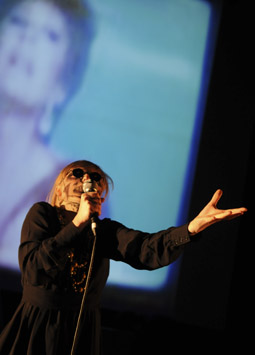
They Live performing Here to Chew Bubblegum, NightTime: Petty Theft, Performance Space
photo by Heidrun Löhr
They Live performing Here to Chew Bubblegum, NightTime: Petty Theft, Performance Space
Performance Space: NightTime: Petty Theft, curators Lara Thoms, Rosie Dennis, Rebecca Conroy; CarriageWorks, Sydney, June 19
RealTime issue #91 June-July 2009 pg.
© Megan Garrett-Jones; for permission to reproduce apply to realtime@realtimearts.net

 Turkish musician Erdem Helvacioglu is best known for his work with electric guitar and computer processing, drawing favourable comparisons with guitar/laptop artist Christian Fennesz (although Helvacioglu offers a significantly more polite if somewhat florid version of even Fennesz’s most accessible music). However with his latest release, Wounded Breath, Helvacioglu seems largely to have eschewed the guitar and instead produced an album of electroacoustic compositions.
Turkish musician Erdem Helvacioglu is best known for his work with electric guitar and computer processing, drawing favourable comparisons with guitar/laptop artist Christian Fennesz (although Helvacioglu offers a significantly more polite if somewhat florid version of even Fennesz’s most accessible music). However with his latest release, Wounded Breath, Helvacioglu seems largely to have eschewed the guitar and instead produced an album of electroacoustic compositions. Lucas Abela has been exploring noise performance using a variety of self-constructed instruments for over a decade. Since 2003 Abela’s instrument of choice has been a sheet of glass, which he plays by humming, squealing and raspberry-blowing against it, the miked signal subsequently fed through a utility belt of effects pedals. The performance is spectacular and concludes when he smashes the glass over his head. Showmanship aside, the sounds Abela elicits in his improvised onslaughts are often extraordinary.
Lucas Abela has been exploring noise performance using a variety of self-constructed instruments for over a decade. Since 2003 Abela’s instrument of choice has been a sheet of glass, which he plays by humming, squealing and raspberry-blowing against it, the miked signal subsequently fed through a utility belt of effects pedals. The performance is spectacular and concludes when he smashes the glass over his head. Showmanship aside, the sounds Abela elicits in his improvised onslaughts are often extraordinary.



















